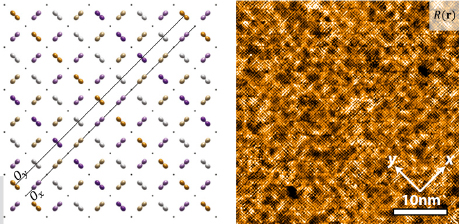Finding the 'heart' of an obstacle to superconductivity
By Bill Steele

A team at Cornell and Brookhaven National Laboratory has discovered that previously observed density waves that seem to suppress superconductivity are linked to an electronic “broken symmetry,” offering an important clue to why superconductivity doesn’t happen at higher temperatures.
“This exotic state has been predicted for decades,” said J.C. Séamus Davis, the James Gilbert White Distinguished Professor in the Physical Sciences at Cornell and director of the Center for Emergent Superconductivity at Brookhaven National Laboratory. “It is a pattern of electronic structure in a crystal that has never been seen experimentally before.”
The results were reported July 2 online in the Proceedings of the National Academy of Sciences.
Superconductivity, where an electric current moves with zero resistance, is seen in metals cooled almost to absolute zero (−273.15 degrees Celsius or −459.67 Fahrenheit). Newly discovered materials superconduct at temperatures up to around 150 degrees C above absolute zero. Moving that temperature higher – even up to room temperature – could lead to a revolution in motors, generators and power transmission.
Among the more interesting and important new superconductors are cuprates, which are made up of layers of copper and oxygen atoms interweaved with layers of other elements. Electric charges around atoms in the “doping” layers alter the arrangement of electrons in the copper oxide layers, allowing some electrons to form tightly linked “Cooper pairs” that can move freely to conduct electricity without resistance.
With little or no doping, cuprates are, paradoxically, insulators. With enough doping they achieve superconductivity. In between is a phase called the “pseudogap,” where many electrons that ought to be available to form Cooper pairs appear to be absorbed by another electronic state. The pseudogap state often appears at much higher temperatures, so finding how it holds off the superconductive state is a major scientific and practical goal.
Davis studies these materials with a scanning tunneling microscope (STM), that can scan a surface in steps smaller than the width of an atom, reading the energy levels of electron. Observations have shown that in the pseudogap state, electrons in cuprates form “density waves” – alternating rows of many or fewer electrons, like the alternating compression of air molecules in sound waves. Theorists suggest the presence of these waves might block superconductivity.
The copper oxide layers in cuprates are made up of L-shaped cells consisting of a copper atom joined to two oxygen atoms, linked together in orderly rows. Another pseudogap phenomenon previously observed at Cornell is that the energy levels of the electrons are mismatched between “east-west” versus “north-south” bonds.
In a radical new approach, the researchers created separate images that showed the electronic structure of a cuprate just around the copper atoms, just around the oxygen atoms “east and west” of the copper and just around the oxygen atoms “north and south.” They found that the asymmetry varies gradually from one unit cell of the crystal to the next, and a graph of the changes looks like the familiar sine wave, paralleling the observed density waves.
“You have to know your enemy to vanquish him,” Davis said. “Here at last we reveal the identity of that enemy. That density wave is modulating the asymmetry. There are more electrons ‘north’ than ‘west’ of a copper atom at one location. As you pull back you see that this property is varying in space so that, after half a wavelength, there are more electrons ‘west’ than ‘north’ of their copper atom; after a full wavelength, there are more electrons to ‘north’ than ‘west’ once again. Then the cycle repeats.”
Eun-Ah Kim, associate professor of physics, and Michael Lawler, adjunct professor of physics, first suggested that Davis look for the broken symmetry. The idea of a relationship between that and density waves was proposed by Subir Sachdev of Harvard University. “It would be a terrible coincidence if you discovered this broken symmetry, and you discovered the density waves modulating it, and yet they were not related,” Davis concluded.
The research is funded primarily by the U.S. Department of Energy, and the United Kingdom’s Engineering and Physics Research Council. Collaborators include scientists at Harvard, Binghamton University and in Canada, Japan, Germany and Scotland.
Media Contact
Get Cornell news delivered right to your inbox.
Subscribe